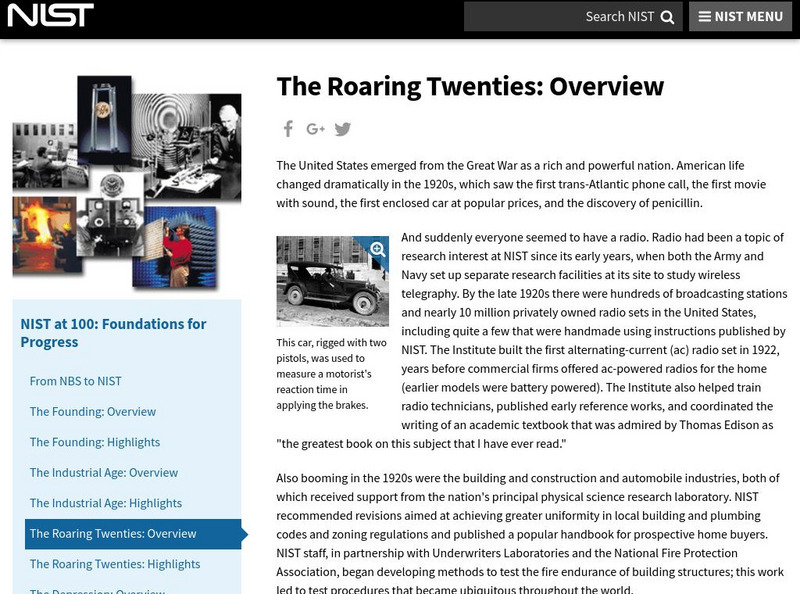Hi, what do you want to do?
Curated OER
Roaring Twenties: The Impact of High School on its Students Over Time
Eleventh graders compare the American high school experience of the 1920's to today. In this historical perspectives lesson, 11th graders examine surveys from 1924 high school students and then create their own surveys for today's high...
Curated OER
The Other Side of Paradise
Eleventh graders explore the life and writing of F. Scott Fitzgerald. They examine the youth culture of the 1920's and compare it to their own. They practice using some of the biographer's or archivist's tools for studying a person.
Curated OER
Early Jazz
Learners gain an understanding of early jazz. They study Dixieland and the Roaring Twenties. They examine the American historical significance and cultural implications of early jazz.
Curated OER
What Caused the Great Depression?
Analyze the many causes of major political, economic, and social developments during the 1920s and 1930s, with emphasis on the Great Depression. Read photographs from the 1920's and the 1930's, then write a brief explanation of what you...
Curated OER
1920’s Questions
In this 20th century history worksheet, students respond to 50 multiple choice questions about events and significant figures of 1920's America.
Curated OER
Key Ingredients: America by Food
Students participate in a series of activities to explore the types of food Americans eat, how food choices differ in various parts of the country, and how the availability of various foods has changed over time.
Curated OER
Venn Diagram: Maine And the U.s.
Learners compare and contrast major events in U.S. histroy using a Venn diagram. They focus on how the events affected their state and the country as a whole. Events expolred include World War I, the Great Depression, Prohibition, the...
Curated OER
Black American Musicans: Precursors of Jazz
Students trace the course of Black music from the 1900's to the beginning of the jazz age. They realize that when education is defined as enlightened training for a place in society and for individual personal development, it was highly...
Curated OER
F. Scott Fitzgerald: The Great American Dreamer
Students explore how F. Scott Fitzgerald was one of the most important writers of the twentieth century. In novels such as Tender is the Night, This Side of Paradise, and The Great Gatsby, he captured the mood and manners of his time.
Curated OER
The 1920s: The Rise of Consumer Culture
Students examine economic, social, and cultural aspects of the 1920s. They provide a brief political history of the 1920s, focusing on the death of Warren Harding (Was he poisoned by his wife?) and develop skills in analyzing...
Curated OER
The Roarding 20's
Tenth graders are introduced to the social, economic and political developments of the 1920s. Using historical developments that are part of the indicator, they create a three-dimensional graphic organizer.
Curated OER
Key Ingredients: America By Food
In this set of five lessons, students analyze the important of food traditions, identity, and history. Students analyze how food traditions contribute to family identity, investigate family food traditions through interviews, and compare...
Curated OER
Social Effects of WWII on SC
Fourth graders compare how the events in the Charleston Harbor affected South Carolinians versus people in other parts of the U.S. In this American history lesson plan, 4th graders watch a video clip, discuss sections of a book, and...
Curated OER
Giggle Water & Struggle Buggies
Here is a lesson that acquaints learners with the 1920s. They will use primary source documents to create original skits. Students choose a character from the 1920s, become that character, and then share what they have learned through...
Curated OER
Jazz and Math: Rhythmic Innovations
Students watch a segment of the PBS Ken Burns JAZZ documentary about Buddy Bolden creating the "Big Four." They compare and contrast the rhythms of marches and jazz based on the examples in the film, and explore notation, subdivision of...
Curated OER
Bank on it! Worksheet
In this weather worksheet, students fill in a paragraph with words from a word bank that represent the weather. Students fill in 17 words into the paragraph.
Curated OER
STORY DEVELOPMENT THROUGH JAPANESE ART
Eighth graders create a story to explain the art object being studied. The story displays students knowledge of writing conventions, elements of a short story, literary conflict, and the use of descriptive text.
Curated OER
1920's Word Search
In this word search worksheet, students identify twenty four words related to the 1920's. Examples include Henry Ford, dancing, lifestyle changes, and Hoover.
Curated OER
U.S. History
In this U.S. history worksheet, 5th graders complete multiple choice questions about important events in U.S. history. Students complete 5 multiple choice questions.
Curated OER
Social Studies Review for Grade 5 (5.1)
In this social studies review for grade 5 (5.1) worksheet, 5th graders answer 25 multiple choice questions in a standardized test format about U.S. history.
Curated OER
Reality vs. Fantasy
In this reality and fantasy worksheet, young scholars label sentences as either being reality and fantasy, and then complete a Venn Diagram for a dragon and a dinosaur. Students label 10 sentences.
Georgia Department of Education
Ga Virtual Learning: American Literature: The Great Gatsby: The Roaring Twenties
This lesson focuses on the Roaring Twenties, an era of great economic growth, widespread prosperity, and new technologies. This is era featured in The Great Gatsby; it began at the end of WWI and ended with the Stock Market crash in...
CommonLit
Common Lit: "The Roaring Twenties" by Mike Kubic
A learning module that begins with "The Roaring Twenties" by Mike Kubic, accompanied by guided reading questions, assessment questions, and discussion questions. The text can be printed as a PDF or assigned online through free teacher...
National Institute of Standards and Technology (NIST)
Nist: The Roaring Twenties
The Roaring Twenties - what were the firsts? What major event happened in 1929? Find out in this article.




























